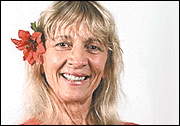


Bodytalk
Question: What exactly is acupuncture, and how does it work? Acupuncture is a
valuable healing toolAnswer: Acupuncture has been practiced in China for over 3000 years, and it's still relied upon today as a valuable healing tool.
In Chinese medicine, no symptom or complaint is viewed in isolation. Rather, the body, mind and soul are evaluated together. The goal of acupuncture is to create harmony within the body by restoring the flow of Qi (pronounced chee). Qi is considered the life force involved in all body functions -- breathing, heartbeat, metabolism and even emotions.
Qi collects in the organs and travels through energy channels in the body called meridians. The Chinese believe that diseases occur when the circulation of Qi is interfered with, whether by injuries or other influences. By redirecting the flow of Qi, acupuncture can help cure disease, prevent illness and restore harmony.
Here's what to expect from an acupuncture treatment.
Acupuncture needles are inserted at various points along the meridians - the location depends on the health problem. Once inserted, the needles may be twirled or moved in a back-and-forth motion. During treatment, the patient either lies down or takes a relaxed sitting or standing position. The insertion of the needles is rapid and virtually painless. Depending on the desired effect - stimulating or tranquilizing - the needles are inserted either perpendicularly or obliquely. The needles are usually left in for 15 to 60 minutes.
It's believed that the needle insertion may stimulate the production of endorphins -- natural protein substances manufactured by the brain, which have a pain killing effect.
Another theory proposes that the stimulation of the acupuncture points prevents pain impulses from reaching the brain.
Acupuncture is primarily used to relieve pain, but also can be used to treat more than 40 disorders. These include acute conditions such as skin and respiratory diseases, migraines, allergies, gynecological disturbances and urinary tract complaints.
A course of treatment generally requires 10 or more sessions, with costs averaging $50 per session. Treatments are usually performed over several days or weeks. The interval between sessions can vary as therapy progresses.
Look for an acupuncturist certified by the National Certification Commission for Acupuncture and Oriental Medicine or The American Association of Acupuncture and Oriental Medicine. They recommend that physicians who practice acupuncture have a minimum of 200 hours of training.
Q: My brother is taking grape seed extract, but he doesn't seem to know exactly why. He's just been told it's good for his health. Is this true, and if it is, why?
A: The seeds and skins of grapes are very rich in proanthocyanidins, which are members of the family of phytochemicals called flavonoids. Proanthocyanidins are exceptionally powerful antioxidants when they are bound together, as they are in grape seeds and skins. In their "bound" form they have come to be referred to as "OPCs." OPCs have been marketed for decades in Europe, but only for medicinal purposes. In the United States, OPCs are now among the top 10 best-selling herbal remedies.
Medicinally, they are most commonly used in the treatment of vein and capillary disorders, and disorders of the retina (eye) such as macular degeneration.
Stephenie Karony is a certified health
and fitness instructor, a personal trainer and the author of
"Body Shaping with Free Weights." Send questions to her at
P.O. Box 262, Wailuku Hi. Her column appears on Wednesdays.